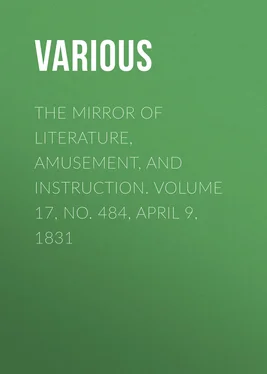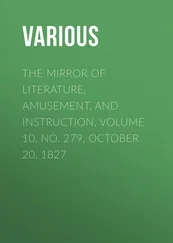Various - The Mirror of Literature, Amusement, and Instruction. Volume 17, No. 484, April 9, 1831
Здесь есть возможность читать онлайн «Various - The Mirror of Literature, Amusement, and Instruction. Volume 17, No. 484, April 9, 1831» — ознакомительный отрывок электронной книги совершенно бесплатно, а после прочтения отрывка купить полную версию. В некоторых случаях можно слушать аудио, скачать через торрент в формате fb2 и присутствует краткое содержание. Жанр: foreign_antique, periodic, Развлечения, foreign_edu, на английском языке. Описание произведения, (предисловие) а так же отзывы посетителей доступны на портале библиотеки ЛибКат.
- Название:The Mirror of Literature, Amusement, and Instruction. Volume 17, No. 484, April 9, 1831
- Автор:
- Жанр:
- Год:неизвестен
- ISBN:нет данных
- Рейтинг книги:4 / 5. Голосов: 1
-
Избранное:Добавить в избранное
- Отзывы:
-
Ваша оценка:
- 80
- 1
- 2
- 3
- 4
- 5
The Mirror of Literature, Amusement, and Instruction. Volume 17, No. 484, April 9, 1831: краткое содержание, описание и аннотация
Предлагаем к чтению аннотацию, описание, краткое содержание или предисловие (зависит от того, что написал сам автор книги «The Mirror of Literature, Amusement, and Instruction. Volume 17, No. 484, April 9, 1831»). Если вы не нашли необходимую информацию о книге — напишите в комментариях, мы постараемся отыскать её.
The Mirror of Literature, Amusement, and Instruction. Volume 17, No. 484, April 9, 1831 — читать онлайн ознакомительный отрывок
Ниже представлен текст книги, разбитый по страницам. Система сохранения места последней прочитанной страницы, позволяет с удобством читать онлайн бесплатно книгу «The Mirror of Literature, Amusement, and Instruction. Volume 17, No. 484, April 9, 1831», без необходимости каждый раз заново искать на чём Вы остановились. Поставьте закладку, и сможете в любой момент перейти на страницу, на которой закончили чтение.
Интервал:
Закладка:
Various
The Mirror of Literature, Amusement, and Instruction / Volume 17, No. 484, April 9, 1831
CORFE CASTLE
The annexed Engravings are an interesting page in the early history of our country, and deserve all the space we have appropriated to them. Their political notoriety, of much less interesting character, we leave to be set down, said, sung, or set aside, elsewhere.
Corfe Castle nearly adjoins a town of the same name: both are situate in the Isle of Purbeck; and their histories are so incorporated, that we shall not attempt their separation.
The town, according to the Beauties of England and Wales , vol. iv. p. 386, is nearly in the centre of the Isle, at the foot of a range of hills, on a rising ground, declining to the east. Its origin must undoubtedly be attributed to the Castle, which existed previous to the year 980; though the town itself does not appear to have attained any importance till after the Conquest, as it was wholly unnoticed in the Domesday Book. The Manor and Castle seem always to have descended together, and were often granted to princes of the blood, and the favourites of our kings, yet as often reverted to the Crown by attainder or forfeiture. In the reign of Richard the Second, they were held by Thomas Holland, Earl of Kent, jointly with Alicia, his wife. In the reign of Henry the Fourth, they were granted to the Beauforts , Earls of Somerset; but were taken from that family by Edward the Fourth, who bestowed them successively on Richard, Duke of York, and George, Duke of Clarence; on the attainder of the latter, they reverted to the Crown. Henry the Seventh granted them to his mother, the Countess of Richmond, for life. In the 27th of his successor, Henry the Eighth, an act of parliament was passed, by which they were given to Henry, Duke of Richmond, his natural son. After his death they reverted to the Crown, and were, by Edward the Sixth, bestowed on the Duke of Somerset; whose zeal for the Reformation was undoubtedly invigorated by the numerous grants of abbey lands made to him after the suppression of the monasteries. On the duke’s attainder, the demesne lands of the Castle were leased for twenty-one years, on a fee-farm rent of 7l. 13s. 4d. In the 14th of Elizabeth, the Castle and Manor, with the whole Isle of Purbeck, were granted to Sir Christopher Hatton, whose heirs continued possessors till the commencement of the 17th century, when the Manor and Castle were given by Sir William Hatton to his lady, Elizabeth, daughter of Thomas, Earl of Exeter, and afterwards second wife to Lord Chief Justice Coke, who sold them, in the year 1635, to Sir John Bankes, Attorney-General to Charles the First, and afterwards Lord Chief Justice of the King’s Bench. His descendant, Henry Bankes, Esq. and representative for this borough, is the present owner.
Though this is an ancient borough by prescription, it was not incorporated till the 18th of Queen Elizabeth, when a charter was obtained by Sir Christopher Hatton, by which the inhabitants were invested with the same liberties as those of the Cinque Ports; besides being favoured with various other privileges. This charter was afterwards confirmed by James the First and Charles the Second. The government of the town is vested in a mayor and eight barons—the barons are those who have borne the office of mayor. The first return to, parliament was made in the 14th of Elizabeth. The right of election is possessed by all persons within the borough who are “seized in fee, in possession, or reversion, of any messuage, or tenement, or corporal hereditament; and in such as are tenants for life, or lives; and in want of such freehold, in tenants for years, determinable on any life, or lives, paying scot and lot.” 1 1 Hutchins’s Dorset, vol. i, p. 279, 2nd edit.
The number of voters is between forty and fifty.
Corfe Castle “stands a little north of the town, opposite to the church, on a very steep rocky hill, mingled with hard rubble chalk stone, in the opening of those ranges of hills that inclose the east part of the Isle. Its situation between the ends of those hills deprives it much of its natural and artificial strength, being so commanded by them, that they overlook the tops of the highest towers; yet its structure is so strong, the ascent of the hill on all sides but the south so steep, and the walls so massy and thick, that it must have been one of the most impregnable fortresses in the kingdom before the invention of artillery. It was of great importance in respect to its command over the whole Isle: whence, our Saxon ancestors justly styled it Corf Gate, as being the pass and avenue into the best part of the Isle.”
The Castle is separated from the town by a strong bridge of four very high, narrow, semi-circular arches, crossing a moat of considerable depth, but now dry. This bridge leads to the gate of the first ward, which remains pretty entire, probably from the thickness of the walls, which, from the outward to the inner facing, is full nine yards. The ruins of the entrance to the second ward, and of the tower near it, are very remarkable. “The latter (which once adjoined to the gate) was separated with a part of the arch at the time of the demolition of the Castle, and is moved down the precipice, preserving its perpendicularity, and projecting almost five feet below the corresponding part. Another of the towers on the same side is, on the contrary, inclined so much, that a spectator will tremble when passing under it. The singular position of these towers seems to have been occasioned through the foundations being undermined (for blowing them up) in an incomplete manner. On the higher part of the hill stands the keep, or citadel, which is at some distance from the centre of the fortress, and commands a view of boundless extent, to the north and west. It has not hitherto suffered much diminution from its original height; the fury of the winds being resisted less by the thickness of the walls than by the strength of the cement. The upper windows have Saxon arches, but are apparently of a later date than any other part of the building west of the keep, the stones of which being placed herring-bone fashion prove it to be of the earliest style. The Chapel is of a very late date, as appears from its obtuse Gothic arches; and I have really an idea that almost all the changes of architecture, from the reign of Edgar to that of Henry the Seventh, may be traced in this extensive and stupendous ruin.
“We could not view without horror the dungeons which remain in some of the towers: they recalled to our memory the truly diabolical cruelty of King John, by whose order twenty-two prisoners, confined in them were starved to death. Matthew of Paris, the historian, says, that many of those unfortunate men were among the first of the Poitevin nobility. Another instance of John’s barbarous disposition was his treatment of Peter of Pontefract, a poor hermit, who was imprisoned in Corfe Castle for prophesying the deposition of that prince. Though the prophecy was in some measure fulfilled by the surrender which John made of his crown to the Pope’s Legate, the year following, yet the imprudent prophet was sentenced to be dragged through the streets of Wareham, tied to horses’ tails.” 2 2 Maton’s Observations, vol. i. p. 12.
The exact period when this fortress was erected is unknown; though some circumstances render it probable that it was built by King Edgar. That it did not exist previously to the year 887, or 888, the time when the Nunnery at Shaftesbury was founded, is certain, from an inquisition taken in the fifty-fourth of Henry the Third; wherein the jurors returned, “that the Abbess and Nuns at Shaston (Shaftesbury) had without molestation, before the foundation of the Castle at Corfe , all wrecks within their manor of Kingston, in the Isle of Purbeck.” Mr. Aubrey, in his Monumenta Britannica , observes, he was informed, “that mention was made of Corfe Castle in the reign of King Alfred; yet it seems very improbable that this should be the fact; for if it had actually existed in the time of that monarch, it would surely have been more publicly known. The short reigns that succeeded would not allow time for so extensive an undertaking; but Edgar enjoyed more peace than almost any of his predecessors, was superior in wealth and power, and a great builder; he having founded, or repaired, no fewer than forty-seven monasteries.” To him, then, the origin of this castle may with the greatest probability be ascribed, as his second wife, Elfrida, resided here at the commencement of her widowhood. During this residence was committed the foul murder on King Edward, Edgar’s son and successor, of which William of Malmesbury relates the ensuing particulars.
Читать дальшеИнтервал:
Закладка:
Похожие книги на «The Mirror of Literature, Amusement, and Instruction. Volume 17, No. 484, April 9, 1831»
Представляем Вашему вниманию похожие книги на «The Mirror of Literature, Amusement, and Instruction. Volume 17, No. 484, April 9, 1831» списком для выбора. Мы отобрали схожую по названию и смыслу литературу в надежде предоставить читателям больше вариантов отыскать новые, интересные, ещё непрочитанные произведения.
Обсуждение, отзывы о книге «The Mirror of Literature, Amusement, and Instruction. Volume 17, No. 484, April 9, 1831» и просто собственные мнения читателей. Оставьте ваши комментарии, напишите, что Вы думаете о произведении, его смысле или главных героях. Укажите что конкретно понравилось, а что нет, и почему Вы так считаете.












